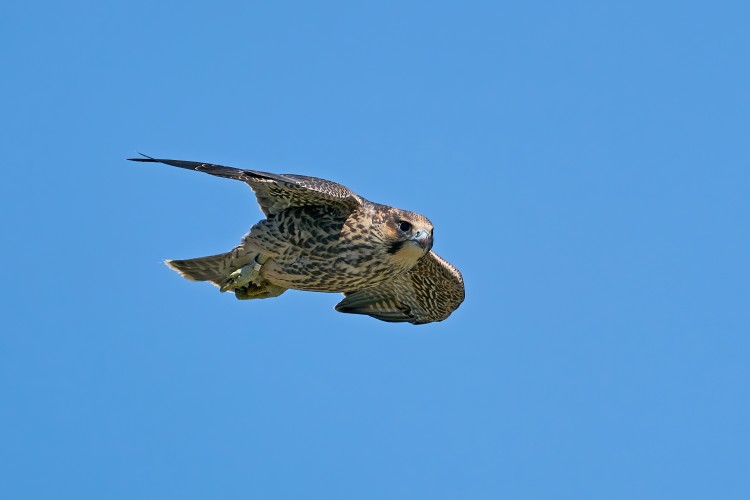Feathered Speed Demons: Tracking the World's Fastest Birds
Birds are some of the most fascinating creatures on Earth, and when it comes to speed, they reach heights and velocities that leave other animals in the dust. Let’s dive into some fun facts about the fastest birds in the world, from supersonic hunters to featherlight flyers.

Young Peregrine Falcon in flight
The Peregrine Falcon is the undisputed speed champion in the bird world. In a hunting dive known as a stoop, this bird can reach speeds over 240 mph (386 km/h). That makes it not only the fastest bird, but the fastest of all animals! (You may have heard of the speedy Cheetah, which with a sprint speed up to 75 mph, is the fastest land animal). Its streamlined body and stiff feathers reduce drag, while powerful flight muscles give it that incredible thrust. When it sees prey from high above, it tucks in its wings and plunges headfirst, aiming to strike at top speed.
Next up is the Golden Eagle. It’s not quite as fast as the Peregrine Falcon when diving, but it can still reach speeds around 150–200 mph (240–320 km/h) in stoops. It’s also one of the largest birds of prey, with a wingspan that can reach over seven feet. This size gives it great leverage and power, helping it glide and dive with impressive control.
Other fast-diving birds include the Saker Falcon (up to 200 mph) and the Gyrfalcon (up to 130 mph).
The White-throated Needletail, a large species of swift, claims the title of fastest level flier. It can cruise at speeds of up to 105 mph (169 km/h) without ever having to dive. These swifts spend most of their lives in the air, even sleeping while on the wing. Their streamlined shape and long, narrow wings reduce drag and help them maintain prolonged, high-speed flights.
The Common Swift is another aerial marvel. It can reach speeds around 70 mph (112 km/h) during normal, level flight. These birds also spend almost their entire lives flying—eating, sleeping, and mating while airborne. They only touch down to nest. Their wings and tail are especially adapted for agile maneuvering, allowing them to dart and chase insects with precision.
Frigatebirds may not thought of as speedsters, but they’re masters of efficient, energy-saving flight. The Magnificent Frigatebird is one example. It can glide on thermals for hours without flapping, and its lightweight body and wing shape allow it to stay aloft with minimal effort. It can reach a top speed of around 95 mph (153 km/h), in part due to having the largest wing size per body weight of all bird species.
Another impressive flier is the Eurasian Hobby. This small falcon often reaches speeds up to 90 mph (145 km/h) when chasing dragonflies or small birds. Its high-speed pursuit capabilities make it a remarkable aerial hunter.
These birds have evolved their speed in different ways. Falcons rely on steep dives to pick up speed. Swifts and frigatebirds develop speed and endurance through streamlined bodies and specially designed wings. Eagles blend power and size, using their strength to dive swiftly too.
Speed isn’t just about velocity—it’s also about purpose. Falcons and eagles use it to catch prey. Swifts need speed to dodge and capture insects mid-air, and frigatebirds soar to find food far out at sea. Each species showcases how evolution shapes birds to meet their environmental needs.
For birdwatchers and backyard birders, observing these fast flyers can be thrilling. Falcons and swifts can appear as blurred streaks overhead, so using binoculars and scanning the skies regularly to spot these speedy birds. Look for falcons near cliff faces or tall buildings where they can build high nests for their stoops. Swifts will frequent open skies and sometimes roost in groups near urban areas or countryside.
These amazing speedsters show how birds push the boundaries of flight. Whether diving at incredible speeds or cruising non-stop for hours, their adaptations are a marvel of nature. Next time you glance up and see a swift darting by or spot a falcon silhouette on a building, you’ll know there’s more behind that blur—traits honed by evolution over millions of years!





Comments
Be the first to comment
Thank you!